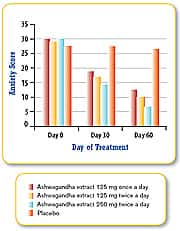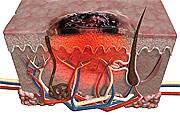Life Extension Magazine®
Have you ever noticed how different a person’s facial expression is when they are fatigued or under stress? A rested-relaxed person can appear years younger compared to when they are fatigued and/or stressed. With the newly emerging field of psychodermatology, scientists are realizing that protecting our skin from accelerated aging is not just about using external sun blocks and moisturizers. Studies show that our emotions, particularly stressful ones, can unleash a torrent of free radicals and stress hormones such as cortisol that not only age our skin but cause a wide range of allergic and inflammatory skin ailments.1,2 Dermatologists are now recognizing that when emotions such as stress and anxiety are creating havoc within the skin, there is little in their pharmacopeia that can solve the problem. It is at the junction of the skin that physicians and psychiatrists truly see the interaction of the mind/body connection. Protecting the skin from aging and disease is a two-fold process that involves addressing both internal and external factors. Fortunately, there are compelling data that a number of herbal compounds can provide important protection against the onslaught of psychodermatological issues. The good news is that a new oral supplement features a unique combination of three herbal extracts to help protect skin from the inside out. The first two ingredients relieve the damage that emotional stress can inflict on the skin while providing powerful antioxidant protection against skin-destroying free radicals. The third is a fern plant extract that acts as an “internal sunscreen” providing protection against solar ray damage. Together, these scientifically proven ingredients can help offset the harmful effects of sunlight and stress for healthy, younger-looking skin. The Skin Under Assault From the InsidePsychodermatology addresses conditions that result from the interaction between the mind and the skin. Acting through the nervous, immune, and endocrine systems, this new phenomenon is being called the “brain-skin connection”3 that may underlie inflammatory skin diseases triggered or aggravated by stress. Indeed, dermatologists worldwide are recognizing that significant numbers of their patients have underlying psychological components related to their skin complaints.4 It is estimated that anywhere between 30% and 60% of visits to the dermatologist are related to skin problems that result from psychological factors. The psychological impact of stress causes an imbalance of many factors in the body that can destroy vital components of the skin responsible for maintaining its elasticity and firmness. Inflammatory reactions in response to the emotional impact of stress can alter the integrity and function of the skin’s barrier.5 On an endocrine level, internal stress can also prematurely age the skin by increasing levels of the stress hormone cortisol.6 By causing blood vessels to constrict, cortisol limits the transport of essential nutrients into the skin needed for necessary functions such as synthesizing collagen. In fact, the loss of collagen from skin by cortisol has been found to be up to 10 times greater than from all other tissues.5 Stressed individuals also suffer from lower levels of the anti-stress hormone DHEA, which benefits all parts of the body including the skin. Converted into the skin-friendly hormones, estrogen and androgen-type metabolites, DHEA has been shown in numerous studies to help maintain the youthfulness of skin cells.7,8 Examples of these stress-related skin disorders include:
Many people find that when they are stressed, they break out in pimples or hives, and their psoriasis, eczema, or other skin conditions become worse. Reducing stress may therefore offer the key to skin healing.
Meditation, biofeedback, relaxing yoga, self-hypnosis, psychotherapy, and other stress-reduction techniques are helpful for inducing emotional well-being, which is known to affect the physical appearance of skin. Not surprisingly, many people notice that when they feel better, they look better. Another effective approach is to take the herb ashwagandha, a renowned adaptogen that acts in multiple ways to resist the stress that can damage our skin and other parts of the body. Adaptogenic herbs are distinct from other substances since they help to balance endocrine hormones and the immune system in order to maintain optimal homeostasis.11 Ashwagandha has long been used in Ayurvedic medicine and other Asian healing systems to treat stress-related diseases. Rich in flavonoids and steroidal lactones called withanolides, ashwagandha has a number of beneficial properties for safely combating stress and enhancing mood and cognition as seen in a recent human clinical trial. For this randomized, double-blind, placebo-controlled study, 98 chronically stressed adults were assigned to receive a patented standardized extract of ashwagandha. The researchers divided the study participants into four groups to receive: ashwagandha, 125 mg once or twice a day, 250 mg twice a day, or a placebo.12 Their stress levels were measured at the beginning of the study, on days 30 and 60, and biochemical and clinical factors such as blood pressure were measured at the beginning and on day 60. The results were impressive. All three ashwagandha doses reduced stress, with a decrease in the volunteers’ levels of fatigue, headache, muscle pain, heart palpitations, dry mouth, insomnia, irritability, and forgetfulness. In addition, appetite and the ability to concentrate improved. After 60 days, the group taking the lowest dose of 125 mg once a day showed a 62% reduction in anxiety compared with placebo, with anxiety scores decreasing even further in the other two active treatment groups. Those taking the placebo did not show any reduction of stress (see Figure 1 below).
Figure 1. Effect on anxiety scores in chronically stressed adults after treatment with three different doses of ashwagandha extract compared with placebo. Although the exact mechanisms of how ashwagandha works are not fully understood, an important action is its ability to lower blood levels of the stress hormone cortisol.13 Since cortisol competes with the anti-aging substance DHEA in the body, simply reducing excess cortisol has an anti-aging effect. After 60 days, the group taking ashwagandha 125 mg once a day showed a 14.5% reduction in cortisol levels and a 13.2% increase in DHEA levels compared with placebo, while the other two active treatment groups reported even greater benefits.12 In addition, all three groups taking the herbal extract saw a pronounced drop in the blood levels of C-reactive protein, a measure of inflammation within the body. Summing up their findings, the researchers reported that the “daily use of Withania somnifera (ashwagandha) would benefit people suffering from the effects of stress and anxiety without any adverse effects.”12
The Skin Under Assault From the OutsideWhile ashwagandha does much to protect the skin against the damaging effects of stress, the body faces other dangers, including the constant assault of oxidants and free radicals. These damaging substances are produced by the body during normal and extraordinary metabolic reactions, and their levels can rise in response to sunlight, cigarette smoke, and other substances. While warm sunlight feels wonderful on the skin, the moment ultraviolet (UV) light penetrates the skin cells, it begins triggering reactions that damage or destroy a number of cellular structures and components. These include the collagen that is responsible for keeping the skin elastic and strong and the hyaluronic acid that “holds” moisture in to give the skin a supple, “plump” look and also helps bind collagen strands together.
Given that many of us face a daily onslaught of oxidants and free radicals, it makes sense to ensure a generous supply of antioxidants to combat both of these dangers. New research is showing that a patented form of Phyllanthus emblica (from the Indian gooseberry) has powerful antioxidant and free radical-scavenging properties by virtue of the ellagic acid and gallic acid stored within the herb as hydrolysable tannins.14,15 This patented Phyllanthus emblica extract also has a special property that makes it especially helpful for protecting the skin. Sunlight striking the skin forces “storage proteins” in the skin to release iron. The presence of this iron spurs a chemical cascade known as the Fenton reaction, resulting in the formation of several types of free radicals that can damage the skin’s dermal matrix. These photoaging pathways generate dangerous reactive oxygen species that ultimately degrade connective tissue, a hallmark of both cancer and aging of the skin.16 Specifically, exposure to UV light increases collagen-degrading enzymes in the skin called matrix metalloproteinases16 and drives the breakdown of hyaluronic acid – the skin’s natural moisturizer.17 Phyllanthus emblica interferes with these photoaging processes by binding to the iron itself and shielding the skin against the destruction of collagen and other dermal matrix proteins.18 Most other antioxidants cannot do this. In vitro studies show that Phyllanthus emblica directly inhibits the synthesis of collagen-breakdown enzymes by 39%,19 as well as increasing levels of their natural inhibitors in the skin.20 In another in vitro study, a proprietary preparation containing patented extracts of both Phyllanthus emblica and ashwagandha extracts demonstrated an impressive 54% inhibition of collagen-degrading enzymes and an 86% inhibition of those that break down hyaluronic acid,19 highlighting the synergy of these ingredients in combating both extrinsic and intrinsic skin aging. | |||||||
A Natural Sunscreen That Works From Inside the CellsAs we have already learned, sunlight, and UV light in particular, generates free radicals, reactive oxygen species, and photons that “rip apart” skin cells and structures and damage skin DNA that is responsible for ensuring every skin cell fulfills its designated role. Ultraviolet light also destroys specialized immune-system sentinels that live in the skin called Langerhans’ cells charged with destroying harmful substances such as germs, toxins, tumors, or other invaders before they can hurt the skin or penetrate further into the body. The result? Skin that develops lines and wrinkles, sags, dries out, thins, and begins to look like grayed, worn paper. Because this sun-induced damage is subtle, slow to accumulate, and usually painless (unless you get a sunburn), it’s very easy to overlook. Until you look in the mirror one day and discover that your skin has aged markedly.
In addition to creating visibly damaged skin, unprotected sun exposure is the leading cause of skin cancer in the US.21 How much sunlight does it take to cause skin damage, accelerate the aging process, weaken the immune system, or trigger cancer? That is impossible to say given the differences in the amount and intensity of sunlight in different areas of the country, the length of exposure, the type of skin, and so on. So health experts advise everyone to take precautions. Unfortunately, many people are remarkably vulnerable when it comes to protecting their skin against the sun’s harmful UV radiation. They don’t always put on sunscreen. That is, they don’t put it on every single time they go outside, especially if it’s only for a few minutes or if the weather seems a bit overcast. When sunscreen is applied, it is often not spread evenly over every part of the body that might be exposed to the sun or used in sufficient amounts to do the job properly. People also may not re-apply it like they should when they have been outside for a long time or have been sweating or swimming. As a result, many people are exposed to more sunlight more often than they think. Wouldn’t it be nice if instead of having to apply and re-apply sunscreen, you had an “internal sunscreen” and skin protector that worked from inside the cells? A sunscreen that could be swallowed as a supplement, only had to be “applied” once a day, covered every inch of skin “thickly” and evenly, and could not be inadvertently rubbed or washed off? Research suggests that we do have such a sunscreen and that it comes from a tropical fern. For centuries, natives of Honduras have protected themselves against sunburns, tumors, psoriasis, and other skin diseases by ingesting Calaguala, an extract from a fern that scientists have dubbed Polypodium leucotomos. An article in Nature discussed this fern’s anti-tumor effects over 40 years ago,22 and since then numerous studies have demonstrated that it has antioxidant properties,23-25 reduces the number of sunburn cells following exposure to the sun’s UV rays,26,27 protects against UV-induced DNA damage,26 guards the skin’s structure by slowing the movement of cells that release inflammatory substances into the skin,26,28 influences the immune system,26-30 and acts against tumors.22,31,32
An early study, conducted by Harvard researchers on 21 volunteers in 1997, tested whether Polypodium leucotomos extract, taken orally or applied topically, could protect human skin against sun damage.33 Some of the study participants were pre-treated with a light-sensitizing agent, some were not, and then all were exposed to solar radiation. The researchers then assessed the level of skin damage (amount of sunburn, changes in skin pigment, and amount of injury to skin cells). The volunteers then either took an oral dose of Polypodium leucotomos extract or applied it to the skin, and were exposed to solar radiation again. Once again the researchers assessed the effects on the skin, and found that Polypodium leucotomos extract had a protective effect whether it was taken as a supplement or applied to the skin. Specifically, it increased the amount of exposure necessary for adverse skin effects to be induced. The amount of time the volunteers’ skin could tolerate sun before reddening increased nearly three-fold, while in some subjects, the skin could tolerate nearly seven times the amount of exposure before suffering sun damage. In addition, Polypodium leucotomos protected the Langerhans’ cells, which means that it guarded this portion of the immune system from sun-induced damage.33 A 2004 study by the same research group also used human volunteers to determine the effectiveness of Polypodium leucotomos in protecting fair to light skin against sun damage.26 Nine healthy volunteers, some of whom were given oral doses of Polypodium leucotomos extract and some of whom where not, were exposed to varying amounts of UV light. After 24 hours, the researchers took biopsy samples to measure the amount of skin redness due to inflammation (erythema). Those who had taken the extract showed a “significant decrease in erythema,” and microscopic examination of skin cell samples revealed a significant decrease in the number of sunburn cells, damage to DNA, and infiltration of the area by mast cells, which play a role in allergic disorders. The researchers concluded that taking Polypodium leucotomos extract offers “significant protection of skin against UV radiation.”26 Although researchers continue to investigate just how Polypodium leucotomos protects the skin, thus far we know that it slows the proliferation of free radicals that are normally seen with sun exposure and normal metabolic processes.25,34 It also prevents damage to and decomposition of DNA and natural elements that protect the skin (such as Langerhans’ cells), and prevents UV rays from killing skin cells and supporting structures.35 These and other properties suggest that Polypodium leucotomos may serve as an internal sunscreen, making it the missing ingredient in many people’s anti-aging and longevity programs. Beautiful, Healthy Skin
Your skin is more than just an outer coating; it is your armor against “outside” invaders and a reflection of who you are. In order for you to look and feel good, it must be in tip-top shape, protected against the dangers arising from within and without. Three herbs—ashwagandha, Phyllanthus emblica, and Polypodium leucotomos—can help protect your precious skin and give it the tools it needs to stay healthy and beautiful. If you have any questions on the scientific content of this article, please call a Life Extension Wellness Specialist at 1-800-226-2370. | |||||||
| References | |||||||
|








